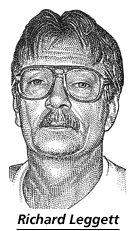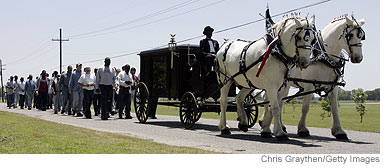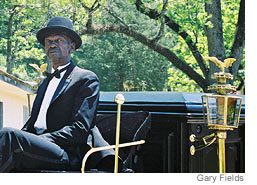This article is one of the Prisonsucks.com Most Disturbing Criminal Justice Stories of 2005.
As inmates age, a prison carpenter builds more coffins
By Gary Fields, The Wall Street Journal, May 18, 2005
TUNICA, La. -- At the Angola state penitentiary here, Richard Leggett, a yellow pencil tucked behind his right ear, put the molding on his latest creation: a 7-foot coffin. He worked with some urgency, sewing and stapling the white bedding inside. He always likes to keep three coffins in stock, so he doesn't run out.

Half a mile away, one of his other hand-made caskets -- birch and pine, stained a rich brown hue -- was being laid into the ground at the prison cemetery. It held the body of a 57-year-old fellow inmate, imprisoned since the 1970s for killing a 13-year-old girl.
As the prison's coffin maker, Mr. Leggett, 53 years old, has been busy. The prison has needed one or two of his caskets in each of the last five weeks. At Angola, 97 percent of inmates now die in prison, up from about 80 percent a decade ago. "I'll probably end up making my own," he says.
The rise of lengthy, mandatory sentences and a nationwide tough-on-crime attitude has resulted in a booming prison population -- 2.1 million last June, compared with 501,886 in 1980 -- and an aging one. The number of inmates dying from natural causes rose to 2,700 in 2002 from 799 in 1982, according to the U.S. Justice Department's Bureau of Justice Statistics.
Inmates often arrive at prison in the physical condition of someone 10 years to 15 years older because of the lack of health care they received while free, according to the American Correctional Association, a group of corrections officials. Chronic illnesses such as HIV, hepatitis and asthma are prevalent among prisoners, as are histories of alcohol and drug abuse, making them more likely to die earlier than normal.
Texas, which had 43 burials in 1975, is burying about 100 prisoners a year now, at a cost of $1,500 each. Oregon has contracted with local funeral homes to cremate unclaimed deceased inmates and store the ashes. The cost is about $432 per cremation.
At Angola, funerals are elaborate affairs, with hand-made coffins pulled to graves by horse-drawn carriages, in rites conducted almost entirely by inmates. Warden Burl Cain believes such services are a stabilizing influence, keeping inmates busy and offering purpose to those who have no hope of leaving alive. "A man wants to be productive, even the ones here," he says.
Once known as the bloodiest prison in America, inmates at Angola used to fashion weapons from innocuous items -- such as toothbrushes and towels -- to maim and kill. A murder a month was considered normal. Today, though, it isn't the Angola of "Dead Man Walking" and "Monster's Ball," two movies filmed here. Now, it's an older Angola, and death often comes from natural causes.
Last year, 29 inmates at Angola died of natural causes, up from six in 1984, even though the population has stayed the same at about 5,100. This year, 23 have died already, none from inmate-on-inmate violence. The prison lost its oldest inmate earlier this year, a 95-year-old, who had been in and out of prison since Harry Truman was president.
During the last decade, there have been only four prison murders at Angola. Some inmates attribute that to what they call "criminal menopause" -- meaning when they hit a certain age, their violent natures dissipate. They also credit the warden, a former teacher who says he came to corrections because high-school students were too unruly.
To deal with its aging population, over 500 inmates at Angola have been trained to perform CPR and there is a hospice here for those who are in the final stages of terminal illnesses. And Warden Cain has created a funeral industry, of which Mr. Leggett's coffin-making is a primary piece. Other inmates make shrouds for the caskets and plan services.
Angola gets society's most serious offenders -- child molesters, murderers and rapists. Two years ago, the prison stopped accepting anyone with a sentence of less than 50 years, meaning few will ever leave.
"A couple of decades after I got here, people actually got out. We used to have call-out every workday where three or four would be called out; they were going home," says Douglas Dennis, 69, who arrived here in 1957 and is serving a double life sentence for killing two prisoners in fights. He is now a writer for the Angolite, an award-winning prison publication whose death listings are scoured by the inmates. Now, "they might as well have welded the doors shut."
About half of those of who die at Angola are buried on the prison's grounds because inmates have lost touch with their families and have no one to collect the remains. "Even your bones don't get a second chance to get out," says Mr. Dennis, the prison's unofficial historian.
The Mississippi River forms three of the institution's four borders and the Tunica Hills, an area of snakes, trees and wild animals, is the fourth. Established as a prison in 1880, Angola gets its name from the plantation that preceded it, which in turn was named for the area of Africa where most of its slaves had come from. Except for the occasional vehicle, there is no mechanical noise. During the day, groups of inmates carrying hoes, shovels and sling blades head to fields where they grow four million pounds of produce, ranging from corn to wheat, each year.
At night, only lights from the various cell blocks on the 18,000-acre compound dot the darkness. The prison grounds are larger than the island of Manhattan.
When there are violent incidents and attempted escapes, they are dealt with swiftly. Offenders are put into Cellblock J, where they remain in 6-by-8 cells, 23 hours a day, for a minimum of six months. They aren't allowed to make telephone calls, smoke or have visitors.
At Angola, "life means life," says Mr. Cain, 62, the short, white-haired warden, who occasionally rides his Harley-Davidson down the 20-mile asphalt highway that dead-ends at the prison's gates. He has mixed feelings about his elderly inmates. "Prison shouldn't be a place for dying old men," he says. "It should be a place for predators."
For years, inmates were buried in flimsy coffins that resembled shipping crates, each costing anywhere from $650 to $900. In June 1995, the prison was preparing to bury Joseph Siegel, a 69-year-old prisoner who had been convicted in 1971 for burglary and murdering a state senator.
As the inmates lifted Mr. Siegel's coffin to lay into the freshly dug grave, his body fell through the bottom of the casket. They carefully laid the coffin over the body and started to shovel dirt over the coffin. The lid then caved in.
Warden Cain, then only in his first year on the job, was disgusted. "Once a man dies, his sentence is complete and there should be dignity in the passing," he says.
He asked some inmates, including Eugene Redwine, who had committed the murder with Mr. Siegel and was known for his carpentry skills, whether they could build a coffin. The inmates agreed, making a coffin in two weeks at a cost of $250, considerably less than the prison had been paying -- and a much higher quality.
Mr. Leggett, now the principal coffin maker here, has been to only one funeral in his 34 years at Angola. It was after the March 2003 death of his mentor and predecessor, Mr. Redwine.
He sat on the front row in the chapel inside the hospice, the area reserved for family. There was no one else there for the 74-year-old man. Mr. Leggett says his mentor taught him the importance of doing his job well. "He said, 'Give it your best effort. If you're going to do something, give it your best.' He instilled that in me."
The two met after Mr. Leggett, who came to prison as a teenager, had been inside a two-man cell for six years. Mr. Redwine, nearly twice Mr. Leggett's age, started teaching the younger inmate about carpentry. Mr. Leggett took to it and began reading everything he could. The two became skilled carpenters, making furniture, rocking chairs, and toys, most of which went to the staff.
Now there's little that Mr. Leggett can't make. All he needs is a picture or a drawing. Cabinets, dressers, and potato bins are all in his repertoire. Most items are used at the prison, and a few are sold. He earns the prison's top wage -- 20 cents an hour -- giving him some spending money for incidentals. He enjoys admiring his finished products, especially the coffins. "If you'd seen what they were buried in before, you'd understand," he says.
Nicknamed "Grasshopper" in his early days here because he was skinny with long limbs, he killed a man and a woman on May 29, 1971, near Amite, La., as he robbed their store. When asked how he remembers the exact date, he spits tobacco juice on the ground, and replies: "Why would I remember it? That's something that weighs on your mind. I have a lot of regrets."
Today, Mr. Leggett is a heavyset man with thick glasses, a bad heart valve and diabetes. Because he's an inmate trustee -- which means he's a low risk for behavior violations -- he isn't under constant guard and lives with the other trustees in a cellblock reserved for them.
A loner, Mr. Leggett spends most of his time in the carpentry shop, working with two assistants, meticulously going over every detail. "You never can tell," he says, standing near one of the oblong boxes, "when one of them is going to be yours." Mr. Leggett has lost touch with most of his relatives and the one he can locate, his son, is serving 20 years in prison in Texas. "I can't go see him and he can't come see me," he says.
It takes him a week to produce a coffin, although he once built one on special order for an oversized inmate in two days. He worked 36 hours straight trying to meet the state requirement that inmates who die of natural causes be buried quickly because they're not embalmed. His most difficult job, he says, was building a tiny 2-foot casket at the request of a prison employee whose child was stillborn. "The child didn't have a chance to live," he says.
This month, Mr. Leggett had to increase his work schedule. Two inmates died and another committed suicide in a five-day period. All were to be buried at the prison cemetery, cleaning out his entire stock of caskets.

For the funeral of Rick Schweickhardt, the man who killed the 13-year-old girl, inmates gathered at a prison park. They followed the prison's hearse -- a black, horse-drawn carriage built by inmates in 1998 to resemble hearses used in the 1800s. Diamond and Laddie, a pair of white, 2,200-pound Percheron horses, descendants of the warden's own champion Percheron, pulled the carriage onto the road to the cemetery, with a little urging from coachman Lloyd "Bones" Bone.

Mr. Bone, a gaunt, unsmiling man with hollow cheeks, has been here since 1971 when he stabbed a man during a knife fight in Algiers, one of the toughest sections of New Orleans. The loser died; the winner got life at Angola.
A few years ago, Warden Cain asked Mr. Bone, who helped tend the horses at the prison stable, to drive the hearse. The job stuck. The warden bought him a tuxedo and a top hat and nicknamed him "Dr. Death." Sitting ramrod-straight atop the hearse, Mr. Bone says he never looks back at the carriage, but adds, "I never forget what I'm carrying." At 64, he frequently thinks about what his own ride will be like: "Who's going to drive the hearse when my time comes?"
Mr. Schweickhardt had no family at the funeral service. His mother died a month before he did and no one came to claim him. Four dozen inmates who knew the deceased walked behind the hearse to Point Lookout II, the prison cemetery opened in 1996.
There have been 97 funerals here in nine years. Its predecessor, Point Lookout I, a short distance away, has 332 marked graves and an unknown number of unmarked ones. Officials stopped using it when, as they began digging a new grave, they discovered human bones were already there.
Since April, funerals have been so frequent that the ground hasn't settled enough on 10 graves to add the simple white crosses used to mark burial plots.
Their voices melodious and clear in the steamy sunshine, the inmates sang "Amazing Grace," with the clomping of the horses' hooves as their only accompaniment. All of them had been at Angola at least 10 years, most for much longer.
Every detail of the service, from the meticulously hand-dug grave, to the braiding of the horses' tails, was done by the inmates. With an extension program from the New Orleans Baptist Theological Seminary, there are ample inmate ministers to conduct the funeral. They quoted scriptures and sang hymns without Bibles or notes. At the cemetery, three inmates asked an assistant warden if they could request that their families bury them here one day.
One by one, the inmates walked to the casket, touched it and looked at the picture of Mr. Schweickhardt on top. At the grave site, the inmates sang a cappella: "I'm free. Praise the Lord, I'm free. No longer bound. No more chains holding me. My soul is resting. It's just a blessing. Praise the Lord, Hallelujah, I'm free."